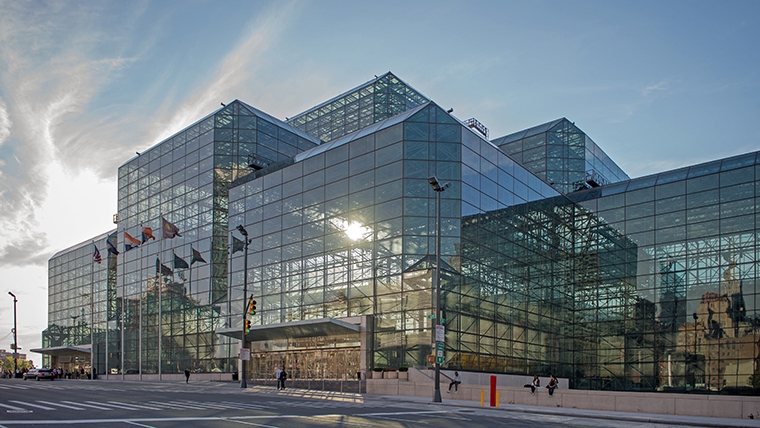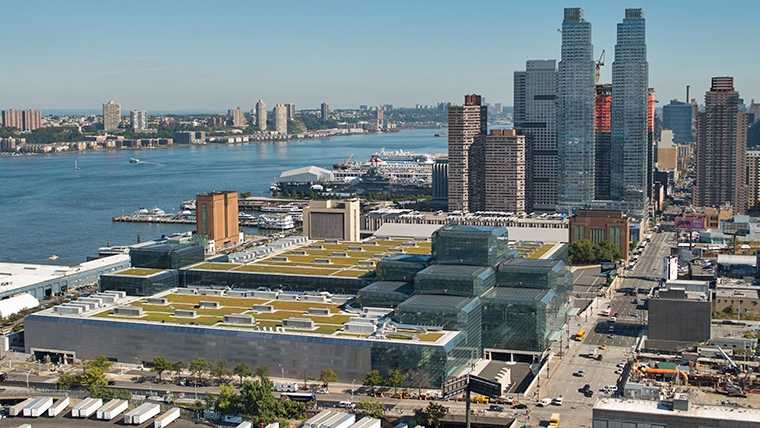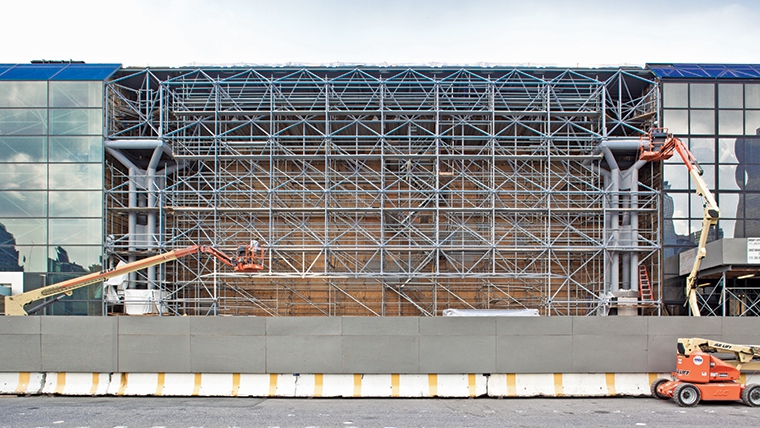Unit System: SI (Metric) IM (Imperial)
JACOB K. JAVITS CONVENTION CENTER
New York, New York, United States
RETROFIT
ORIGINAL
Empire State Development Corporation / New York Convention Center Developme
–
–
Weidlinger Associates
–
–
2013
Cultural
150 ft46 m
3
240,000 ft222,297 m2
Re-Clad
- Highly-Glazed curtainwall ( > 50% glass)
- LEED Silver
- Operational energy performance
- Carbon reduction
- Health and comfort
- Adaptability
- Whole- building energy modeling
- Facade systems commissioning plan
OTHER SYSTEMS INCLUDED IN THE RETROFIT
- HVAC and/or mechanical systems
- Lighting systems
EXTENT OF THE FACADE INTERVENTION
- Glass infill panels were replaced
DESCRIPTION
This exhibit space on Manhattan’s west side has been a benchmark for early space frame structures since its opening in 1982, and represents one of the largest applications of the technology type in the world. I.M. Pei & Partners flexible glass box design can be divided into nine self-contained halls to accommodate trade shows of varying sizes, and serves up to 3.5 million visitors annually.
In 2006 a major renovation and expansion was undertaken to meet the demand for additional exhibit space and performance upgrades. With the original 1982 facade showing signs of aging, a reclad program began in July 2010 to replace the entire curtainwall system, including the removal of the existing facade and the engineering, fabrication and installation of new curtainwall and skylight systems.
The original cladding system was based upon a 10’ x 10’ module split by a vertical mullion, ultimately creating four 5’ x 5’ glass panels per module. The renovation’s new glazing system retains the original 10’ x 10’ grid, but with two 10’ wide by 5’ high glass panels per module.
After three decades of advancement by the glass industry, the new glazing systems increase energy performance dramatically in comparison to the original structure while simultaneously increasing building transparency — ultimately having a dramatic effect on both visitors and building performance. New, insulated glass panels include an assortment of high performance coatings and frit patterns.
The Javits retrofit program was designed around a series of energy performance standards ultimately aimed at LEED Silver certification. Key to the building’s program was the decision to replace the entire cladding system rather than swapping out glass panels, which ultimately allowed for a thermal break to improve the glazing system’s insulation values. While previously operating at 10% below the performance requirements of current energy codes, the post-retrofit convention space is expected to exceed it by 25%.
Enclos and Baker Metal Products provided fabrication services, with Enclos alone handling the assembly and glazing of curtainwall units. Two performance and visual mockups were conducted to confirm these glazing systems. To speed both the removal and installation of the glazing systems, Enclos operated its own dedicated tower crane throughout the construction process and utilized a double picking technique (lifting two units at a time by crane).
This exhibit space on Manhattan’s west side has been a benchmark for early space frame structures since its opening in 1982, and represents one of the largest applications of the technology type in the world. I.M. Pei & Partners flexible glass box design can be divided into nine self-contained halls to accommodate trade shows of varying sizes, and serves up to 3.5 million visitors annually.
In 2006 a major renovation and expansion was undertaken to meet the demand for additional exhibit space and performance upgrades. With the original 1982 facade showing signs of aging, a reclad program began in July 2010 to replace the entire curtainwall system, including the removal of the existing facade and the engineering, fabrication and installation of new curtainwall and skylight systems.
The original cladding system was based upon a 10’ x 10’ module split by a vertical mullion, ultimately creating four 5’ x 5’ glass panels per module. The renovation’s new glazing system retains the original 10’ x 10’ grid, but with two 10’ wide by 5’ high glass panels per module.
After three decades of advancement by the glass industry, the new glazing systems increase energy performance dramatically in comparison to the original structure while simultaneously increasing building transparency — ultimately having a dramatic effect on both visitors and building performance. New, insulated glass panels include an assortment of high performance coatings and frit patterns.
The Javits retrofit program was designed around a series of energy performance standards ultimately aimed at LEED Silver certification. Key to the building’s program was the decision to replace the entire cladding system rather than swapping out glass panels, which ultimately allowed for a thermal break to improve the glazing system’s insulation values. While previously operating at 10% below the performance requirements of current energy codes, the post-retrofit convention space is expected to exceed it by 25%.
Enclos and Baker Metal Products provided fabrication services, with Enclos alone handling the assembly and glazing of curtainwall units. Two performance and visual mockups were conducted to confirm these glazing systems. To speed both the removal and installation of the glazing systems, Enclos operated its own dedicated tower crane throughout the construction process and utilized a double picking technique (lifting two units at a time by crane).
OWNER
Empire State Development Corporation / New York Convention Center Developme
DEVELOPER
DESIGN ARCHITECT
I.M. Pei & Partners
EXECUTIVE ARCHITECT
ENGINEER
CONSTRUCTION MANAGER
GENERAL CONTRACTOR
FACADE CONSULTANT
FACADE CONTRACTOR
OTHER CONSULTANT/CONTRIBUTOR
Empire State Development Corporation / New York Convention Center Developme
DEVELOPER
DESIGN ARCHITECT
I.M. Pei & Partners
EXECUTIVE ARCHITECT
ENGINEER
CONSTRUCTION MANAGER
GENERAL CONTRACTOR
FACADE CONSULTANT
FACADE CONTRACTOR
OTHER CONSULTANT/CONTRIBUTOR
–
1985
Cultural
150 ft46 m
3
–
ORIGINAL FACADE DESIGN
DESCRIPTION
This exhibit space on Manhattan’s west side has been a benchmark for early space frame structures since its opening in 1982, and represents one of the largest applications of the technology type in the world. I.M. Pei & Partners flexible glass box design can be divided into nine self-contained halls to accommodate trade shows of varying sizes, and serves up to 3.5 million visitors annually.
In 2006 a major renovation and expansion was undertaken to meet the demand for additional exhibit space and performance upgrades. With the original 1982 facade showing signs of aging, a reclad program began in July 2010 to replace the entire curtainwall system, including the removal of the existing facade and the engineering, fabrication and installation of new curtainwall and skylight systems.
The original cladding system was based upon a 10’ x 10’ module split by a vertical mullion, ultimately creating four 5’ x 5’ glass panels per module. The renovation’s new glazing system retains the original 10’ x 10’ grid, but with two 10’ wide by 5’ high glass panels per module.
After three decades of advancement by the glass industry, the new glazing systems increase energy performance dramatically in comparison to the original structure while simultaneously increasing building transparency — ultimately having a dramatic effect on both visitors and building performance. New, insulated glass panels include an assortment of high performance coatings and frit patterns.
The Javits retrofit program was designed around a series of energy performance standards ultimately aimed at LEED Silver certification. Key to the building’s program was the decision to replace the entire cladding system rather than swapping out glass panels, which ultimately allowed for a thermal break to improve the glazing system’s insulation values. While previously operating at 10% below the performance requirements of current energy codes, the post-retrofit convention space is expected to exceed it by 25%.
Enclos and Baker Metal Products provided fabrication services, with Enclos alone handling the assembly and glazing of curtainwall units. Two performance and visual mockups were conducted to confirm these glazing systems. To speed both the removal and installation of the glazing systems, Enclos operated its own dedicated tower crane throughout the construction process and utilized a double picking technique (lifting two units at a time by crane).
This exhibit space on Manhattan’s west side has been a benchmark for early space frame structures since its opening in 1982, and represents one of the largest applications of the technology type in the world. I.M. Pei & Partners flexible glass box design can be divided into nine self-contained halls to accommodate trade shows of varying sizes, and serves up to 3.5 million visitors annually.
In 2006 a major renovation and expansion was undertaken to meet the demand for additional exhibit space and performance upgrades. With the original 1982 facade showing signs of aging, a reclad program began in July 2010 to replace the entire curtainwall system, including the removal of the existing facade and the engineering, fabrication and installation of new curtainwall and skylight systems.
The original cladding system was based upon a 10’ x 10’ module split by a vertical mullion, ultimately creating four 5’ x 5’ glass panels per module. The renovation’s new glazing system retains the original 10’ x 10’ grid, but with two 10’ wide by 5’ high glass panels per module.
After three decades of advancement by the glass industry, the new glazing systems increase energy performance dramatically in comparison to the original structure while simultaneously increasing building transparency — ultimately having a dramatic effect on both visitors and building performance. New, insulated glass panels include an assortment of high performance coatings and frit patterns.
The Javits retrofit program was designed around a series of energy performance standards ultimately aimed at LEED Silver certification. Key to the building’s program was the decision to replace the entire cladding system rather than swapping out glass panels, which ultimately allowed for a thermal break to improve the glazing system’s insulation values. While previously operating at 10% below the performance requirements of current energy codes, the post-retrofit convention space is expected to exceed it by 25%.
Enclos and Baker Metal Products provided fabrication services, with Enclos alone handling the assembly and glazing of curtainwall units. Two performance and visual mockups were conducted to confirm these glazing systems. To speed both the removal and installation of the glazing systems, Enclos operated its own dedicated tower crane throughout the construction process and utilized a double picking technique (lifting two units at a time by crane).




